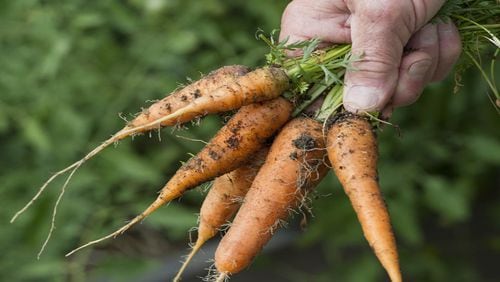It seems everyone is talking about "detox" or considering a "cleanse." Toxins are said to be the problem, but when was the last time anyone explained what detoxes or cleanses actually are? And who needs to do it?
Detoxification is a process that the body performs around the clock utilizing important nutrients from the diet, according to the Academy of Nutrition and Dietitics. It's the process that transforms molecules that need to be removed from the body, or "toxins." They fall into two main categories: molecules that are made in the body as byproducts of regular metabolism (endotoxins), and those that come from outside the body and are introduced to the system by eating, drinking, breathing or are absorbed through the skin (exotoxins).
Endotoxins include compounds such as lactic acid, urea and waste products from microbes in the gut. Exotoxins include environmental toxins and pollutants, pesticides, mercury in seafood, lead from car exhaust and air pollution, chemicals in tobacco smoke, dioxin in feminine care products, phthalates from plastic and parabens from lotions and cosmetics.
Detoxification also is the process by which medications are metabolized, then excreted. Because toxins are potentially dangerous to human health, they need to be transformed and excreted from the body through urine, feces, respiration or sweat. Each person's ability to detoxify varies and is influenced by environment, diet, lifestyle, health status and genetic factors, suggesting some people could require more detoxification support than others. But if the amount of toxin to which a person is exposed exceeds his or her body's ability to excrete them, the toxins may be stored in fat cells, soft tissue and bone, negatively affecting health. This is the rationale that supports the use of practices that support the body's own detoxification capabilities.
Most detoxification programs recommend removing processed foods and foods to which some people are sensitive, such as dairy, gluten, eggs, peanuts and red meat, and eating mostly organically grown vegetables, fruit, whole nonglutenous grains, nuts, seeds and lean protein. Other programs recommend fasting, a potentially risky practice for some people, which may actually suppress detoxification pathways in the body. This is why many health practitioners advise against this practice. Detoxification programs may pose a risk for people with multiple maladies, those who take multiple medications and pregnant or breast-feeding women.
Detoxification support doesn't need to consist of a rigorous plan; doing some or all of the following can support detoxification:
--Maintain adequate hydration with clean water.
--Eat five to nine servings of fruit and vegetables per day.
--Consume enough fiber each day from vegetables, nuts, seeds and whole grains.
--Eat cruciferous vegetables, berries, artichokes, garlic, onions, leeks, turmeric and milk thistle, and drink green tea. These foods support detoxification pathways.
--Consume adequate protein, which is critical to maintaining optimum levels of glutathione, the body's master detoxification enzyme.
--Consider taking a multivitamin/multimineral to fill any gaps in a healthy diet, since certain vitamins and minerals enable the body's detoxification processes to function.
--Eat naturally fermented foods such as kefir, yogurt, kimchi and sauerkraut -- or take a high-quality probiotic -- to help the body manage toxins from microbes that live in the gut.
--Maintain bowel regularity.
The bottom line? For the majority of us, detoxification is a process that our bodies do naturally, day in and day out, so it isn't really needed. But for those wanting to do it, follow the guidelines above.
Q and A
Q: I've been buying bags of carrots that have multiple colors - yellow and purple, as well as orange. Is the nutritional value, particularly beta-carotene, of non-orange carrots less?
A: With the exception of white carrots, all are good sources of carotenoids and other beneficial phytonutrients. Color is the best indicator of this. Orange carrots contain the highest level of total carotenoids, especially beta-carotene, which can be converted to vitamin A. Yellow and purple carrots contain good amounts of the carotenoid lutein, intakes of which have been associated with eye and brain health. Purple carrots contain higher amounts of phenolics, especially anthocyanins, which may be protective against cancer and heart disease. Each carrot type will have varied health effects because of these colored compounds. A healthy dietary pattern contains a variety of fruits and vegetables, which carrots of multiple colors can be a part of. -- Tufts University Health & Nutrition Letter.
RECIPE
This is rhubarb season. Those long stems pair well with apples to make a great fruit dessert. This one is from Cooking Light magazine.
Mom's Rhubarb-Apple Crisp
Cooking spray
12 ounces fresh or frozen rhubarb, thawed, cut into 1/2-inch thick slices
1 1/4 pound Honeycrisp apples, peeled, cored and diced
2/3 cup sugar
1/2 cup all-purpose flour, divided
1 teaspoon vanilla
1/4 teaspoon ground cinnamon
2/3 cup old-fashioned rolled oats
1/2 cup light brown sugar, not packed
3 tablespoons unsalted butter, softened and cut into small pieces.
Preheat oven to 375 degrees. Coat an oval baking pan or dish with cooking spray. Combine rhubarb, apples, sugar, 2 tablespoons flour, vanilla and cinnamon in a medium bowl; toss well and place in prepared baking dish. Combine remaining 6 tablespoons flour, oats and brown sugar in a bowl; mix well. Add butter to mixture. Stir until mixture begins to hold together. Sprinkle oat mixture evenly over rhubarb mixture in baking dish. Bake at 375 degrees until topping is golden brown, filling is thick and bubbly and fruit is tender, about 50 to 55 minutes. Cool 15 minutes before serving. Serves 12.
Per serving: 161 calories, 2 g protein, 32 g carbohydrate, 3.4 g fat, 8 mg cholesterol, 2 g fiber, 4 mg sodium.


/cloudfront-us-east-1.images.arcpublishing.com/ajc/P7DYBH6TO7FEKG4SUXQQKADRXE.jpg)



